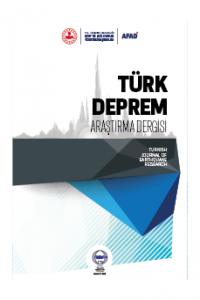Gerçek Zamanda Bir Deprem Olayında Binaların Kullanılabilirlik Kararı İçin Sürekli Ötelenme Ölçümü
Ölçüm aletleri yerleştirilmiş olan yapıların seçilen yerlerinde gerçek zamanlı yer değiştirme, ya ivme-ölçer zaman serisi verilerinin çift entegrasyonu ya da yüksek binaların çatılarına yerleştirilen yüksek örnekleme oranlarına sahip diferansiyel küresel konumlama sistemi (KKS) ile elde edilir. Bu nedenle, sensör verileri bir binanın performans seviyesi ve sağlığı ile ilgilidir. Ötelenme oranları bir yapının hasar durumunun parametrik göstergesi olarak hesaplanır. Tetkik ve/veya kullanılabilirlik kararı almak için çeşitli seviyelerde eşik ötelenme oranları tahmin edilebilir. Ötelenme oranı, arka arkaya seçilen kat çiftlerine konuşlandırılan ivme-ölçerlerden iki kat arasındaki göreceli yer değiştirme kullanılarak hesaplanır. Bununla birlikte, KKS ile ölçülen göreceli yer değiştirmeler zemindeki referansa göre sadece çatıdan elde edilecek şekilde sınırlıdır. Bu nedenle bir bina için sadece ortalama ötelenme oranı elde edilir. Yakın zamana kadar mevcut KKS sistemlerinin saniyede 10-20 kayıt aldığı ve kullanımın sadece uzun periyotlu (T>1 sn) yapılarla sınırlı olduğu bilinmekteydi. Son zamanlarda ise saniyede 50 örnekle kayıt yapan diferansiyel KKS sistemleri başarıyla kullanılmaktadır ve bu KKS yaklaşımının tüm yapı tipleri için gelecekteki faydasını mümkün kılmaktadır. Hem ivme-ölçerlerden hem de KKS kurulumlarından elde edilen verilerle kazanılan deneyim, sistemlerin güvenilir olduklarını, mal sahiplerini ve diğer ilgilileri bilinçli karar almaları noktasında uyarma, önemli sarsıntılar sonrası önceden tanımlanmış eylemleri seçmede pratik alternatifler sağladığını göstermektedir. Ayrıca, bu tür yöntemlerin işletmeler tarafından kabul görmesi, uygulanabilirliklerinin kanıtıdır.
Anahtar Kelimeler:
Ötelenme oranı, kullanılabilirlik, hasar göstergesi, ivme, yer değiştirme, KKS
Real-Time Monitoring of Drift for Occupancy Resumption
At selected locations of instrumented structures, real-time displacements are acquired by either double integration of accelerometer time-series data, or differential global positioning system (GPS) with high sampling ratios deployed at roofs of tall buildings. Thus, sensor data is related to performance level and health of a building. Drift ratios are computed as the parametric indicator of damage condition of a structure. Several levels of threshold drift ratios can be postulated in order to make decisions for inspections and/or occupancy. Drift ratio is computed using relative displacement between two floors computed from accelerometers strategically deployed at select number of pairs of consecutive floors. However, GPS-measured relative displacements are limited to being acquired only at the roof with respect to its reference base - yielding only average drift ratio for a building. Until recently, GPS systems available were limited to 10-20 sps capability – limiting their use only to long-period structures (T>1s). Most recently, up to 50 sps differential GPS systems readily available are successfully used. Thus enabling future usefulness of GPS to all types of structures. Experience with data acquired from both accelerometers and GPS deployments indicates that they are reliable and provide pragmatic alternatives to alert the owners and other authorized parties to make informed decisions and select choices for pre-defined actions following significant events. Furthermore, recent adoption of such methods by financial and industrial enterprises is testimony to their viability.
Keywords:
Drift ratio, occupancy, damage indicator, accelerometer, displacement, GPS,
___
- Applied Technology Council (ATC), 1989. Procedures for Post-Earthquake Safety Evaluation of Buildings, ATC-20, Redwood City, CA.
- Applied Technology Council (ATC). (1997). NEHRP Commentary on the Guidelines for the Seismic Rehabilitation of Buildings, prepared for the Building Seismic Safety Council, published by the Federal Emergency Management Agency, FEMA 274, Washington, D.C.
- Building Occupancy Resumption Program (BORP), 2001. City and County of San Francisco, Department of Building Inspection, Emergency Operation Plan, (Rev. 2001). [www.seaonc.org/member/committees/des_build.html).
- Çelebi M., Sanli A. (2002). GPS in Pioneering Dynamic Monitoring of Long-Period Structures, Earthquake Spectra, Journal of EERI. Volume 18, No. 1, pages 47–61, February 2002.
- Çelebi M., Sanli A., Sinclair M., Gallant S., Radulescu D., 2004. Real-Time Seismic Monitoring Needs of a Building Owner and the solution – A Cooperative Effort, Journal of EERI, Earthquake Spectra, v.19, Issue 1, pp.1-23.
- Çelebi M., 2019, S2HM of Buildings in USA, Book Chapter in Limongelli, Maria Pina, and Çelebi, Mehmet (Eds.) Seismic Structural Health Monitoring: From Theory to Successful Applications, Springer Tracts in Civil Engineering, Springer International Publishing AG., 3-27.
- FEMA352, 2013. Recommended Post-earthquake Evaluation and Repair Criteria for Welded Steel Moment-Frame Buildings (also SAC Joint Venture 2000 prepared for FEMA), Washington, D.C.
- Panagitou M., Restrepo J.I., Conte J. P., Englekirk R. E., 2006. Seismic Response of Reinforced Concrete Wall Buildings, 8NCEE (paper no. 1494), San Francisco, Ca. April 18-22, 2006.
- Porter K., Mitrani-Reiser J., Beck J. L., Ching J., 2006. Smarter Structures: Real- time loss estimation for instrumented buildings, 8NCEE (paper no. 1236), San Francisco, Ca. April 18-22, 2006.
- Safak E., 1999. Wave-propagation formulation of seismic response of multistory buildings, ASCE, Journal of Structural Engineering, vol. 125, no. 4, April 1999, pp. 426-437.
- Başlangıç: 2019
- Yayıncı: Afet ve Acil Durum Yönetimi Başkanlığı (AFAD)
Sayıdaki Diğer Makaleler
Küresel Konumlama Uydu Sistemleri Tabanlı Deprem Gözlemlerinin Duyarlığı
Manisa ve Çevresinde Deprem ve Patlatma Verilerinin Ayırt Edilmesi
Nalan CEYDİLEK, Gündüz HORASAN
Ayşegül ASKAN GÜNDOĞAN, Shaghayegh KARİMZADEH
2019 Türkiye Bina Deprem Yönetmeliğinde Başlıca Yenilikler
Gerçek Zamanda Bir Deprem Olayında Binaların Kullanılabilirlik Kararı İçin Sürekli Ötelenme Ölçümü
Kuzey Anadolu Fay Zonu’nun (KAFZ) Orta Kesimi İçin Yeni Bir Kuvvetli Yer Hareketi Azalım İlişkisi
